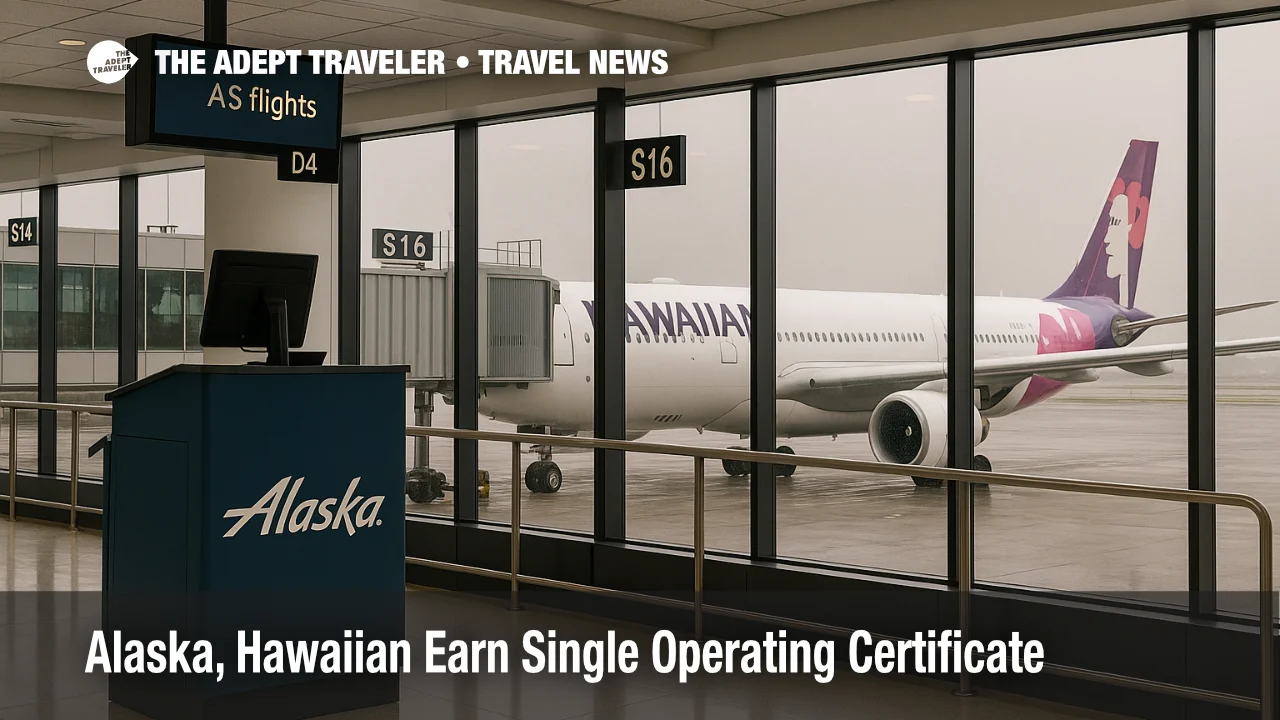Alaska, Hawaiian Earn Single Operating Certificate

Key points
- FAA grants a single operating certificate to Alaska Airlines and Hawaiian Airlines
- Training, policies, procedures, and manuals are now integrated under Alaska Air Group
- Brands remain separate for now, with one passenger system and the AS code planned for spring 2026
- Air traffic control call sign and operating authority shift to Alaska following the SOC
- Alaska has already begun using Hawaiian widebodies for new transoceanic routes from Seattle
Impact
- What Changed
- The FAA issued a single operating certificate, moving all operations under Alaska's certificate while both brands continue to fly
- Who Is Affected
- Travelers booking Alaska or Hawaiian may see back-office integration and ATC callsign changes, but branding and service remain familiar
- Timeline
- Single passenger service system expected by spring 2026, when Hawaiian's HA code sunsets and flights carry AS codes
- What To Do
- Book and manage trips as usual, watch airline emails for reissued itineraries next spring as flight codes and PNR displays update
- Loyalty
- Combined loyalty already live with aligned policies, so accrual and redemption continue with expanded partner reach
Alaska Air Group has reached a major milestone in its integration of Alaska Airlines and Hawaiian Airlines. On October 29, 2025, the Federal Aviation Administration, FAA, approved a single operating certificate that brings the carriers' training, manuals, policies, and procedures under one framework. For travelers, the near-term experience remains consistent, since both brands will continue to operate with their own look and feel, although air traffic control now treats all flights as operating under Alaska's certificate. The bigger traveler-visible change will come next spring, when the two airlines plan to cut over to one booking and passenger system and move all flying to Alaska's AS code.
Alaska and Hawaiian, one certificate, two brands
The single operating certificate, or SOC, is the regulatory checkpoint that allows a merged airline group to run one safety and compliance system across its carriers. It does not require an immediate public rebrand. Alaska and Hawaiian emphasize that the guest experience will continue to be presented under each brand while the back-office work converges. In practical terms, pilots and dispatch communicate with air traffic control using the Alaska callsign, while passenger-facing elements, like Hawaiian's Pualani livery, service style, and onboard products, continue as before.
Codes and systems: what changes when
The most visible shift for customers arrives with the migration to a single passenger service system, PSS, in spring 2026. Alaska states that once the PSS is live, every flight will display the AS code, retiring Hawaiian's HA code after nearly a century. Several outlets and local broadcasters place the target around April 22, 2026, aligning with schedule filings and the PSS cutover window. Until then, Hawaiian's HA code continues to appear on tickets and timetables, even as operations run on Alaska's certificate and callsign.
What this means for booking and day-of-travel
Before the PSS cutover, travelers can keep booking as usual on each airline's site and through travel agencies. After the cutover, Alaska says Hawaiian-branded flights will still be clearly identified across digital channels, but the underlying flight designator will be AS. If you are traveling during the change window, watch for itinerary updates, new e-tickets, or reissued receipts reflecting an AS flight number in place of HA. Your original departure and arrival times and seat selections should carry over. Loyalty accrual and redemption will continue with the combined program, and elite benefits should map across the network.
Network and fleet synergies already visible
Alaska has been using Hawaiian's Airbus A330 widebodies to open and operate new transoceanic routes from Seattle-Tacoma International Airport, including service to Asia. These deployments preview how the merged fleet can expand long-haul options from the Pacific Northwest while maintaining strong Hawaii connectivity. As the SOC streamlines operations and the PSS unifies inventory, the combined planning team gains more flexibility to place the right aircraft on the right routes across seasons.
Background, how a single operating certificate works
In U.S. airline mergers, the SOC is one of two big gates. The first is antitrust and Department of Transportation approval to combine, which Alaska received in 2024 when it completed the purchase of Hawaiian. The second is the FAA's operational approval to run the merged airline under one safety system. The SOC demands extensive harmonization of manuals, training, maintenance, and procedures, which Alaska and Hawaiian now have in place. With that foundation complete, the companies can proceed to align labor agreements and retire parallel IT stacks.
Final thoughts
The SOC is a behind-the-scenes milestone, but it sets up the traveler-visible change to one code and a single booking system by spring 2026. Expect continuity of brand and service on board Alaska and Hawaiian through the transition, with the biggest differences showing up in what your reservation displays and what pilots say on the radio. For many flyers, the payoff will be a broader long-haul schedule built on Hawaiian widebodies and Alaska's Seattle hub, delivered under a unified operational umbrella.
Sources
- Alaska and Hawaiian reach SOC milestone, Alaska Newsroom, Oct 29, 2025
- Alaska Air Group secures single FAA operating certificate, FlightGlobal, Oct 29, 2025
- Hawaiian flights to carry AS code after PSS cutover in spring 2026, Travel Market Report, Oct 29, 2025
- Single PSS and AS code statement, PR Newswire release, Oct 29, 2025
- Alaska launches widebody international flying in Seattle using Hawaiian aircraft, Alaska Newsroom, May 12, 2025
- Merger completion and DOT conditions, Reuters, Sept 18, 2024
